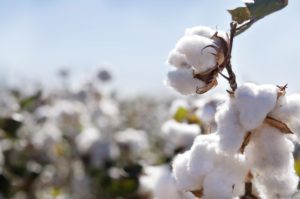With all of the emphasis on ethical diets in recent years, one incredibly important crop may have escaped some consumers’ attention. What you wear can be just as important as what’s on your plate.
It’s hard to overstate how essential cotton is to international supply chains and global industries. With an annual traded value totalling about US$8 billion, the United Nations Conference on Trade and Development reported that this crop is responsible for satisfying 27% of global textile requirements,
At the same time, cotton-growing practices can vary widely. Some operations that produce conventional cotton pay poverty wages for poor labour conditions while using harmful chemicals and leaving a negative impact on the environment. Fortunately, there are alternatives.

What are some of the environmental risks in traditional cotton production?
Conventionally grown cotton is often produced using synthetic fertilisers. In addition, much of the supply is genetically modified to be resistant to pests. The use of synthetic pesticides is another common practice in traditional cotton production.
Depending on the farming techniques that are used, potentially toxic artificial pesticides and fertilisers can wind up in groundwater. This can lead to pollution locally, and contaminants can travel through waterways to locations far away from production sites, damaging marine ecosystems as well as affecting drinking water.
It also takes a lot of water to grow cotton.
The World Wildlife Fund noted that it takes 20,000 litres of water to produce one kilogram of cotton. To put things in perspective, that’s about the amount required to produce a T-shirt and a pair of jeans.
How is organic cotton produced and how does it differ from traditional cotton?
Broadly speaking, all organic goods are produced without the use of toxic pesticides. Instead of using man-made fertilisers, to grow organic cotton, farmers add natural organic matter, including animal manure, to the soil. In addition, most organic standards prohibit goods made with genetically modified organisms (GMOs) from being certified.
While different countries have their own criteria for producing organic cotton, some certifying bodies require that companies must also meet social welfare requirements and quality assurance standards in order to be considered organic.
It’s one thing for companies to claim they grow organic cotton, but a trustworthy and expanding organic cotton market requires independent verification, so look for credible, recognised certification labels on the products you purchase.
When you come across an organic label on a consumer product, look carefully to distinguish which agency has certified the item. Then, you can search online to find out what standards the product must have adhered to in order to be recognised by that organisation. You should also be on the lookout for fine print indicating that only a small portion of the product, or even just part of its packaging, was made with organic materials.
What about Fairtrade cotton?
Fairtrade cotton is produced in a way that provides economic opportunity for farmers and workers on the ground while also promoting more sustainable growing practices.
In exchange for cotton fibre and other raw materials, Fairtrade workers must be paid the Fairtrade Minimum Price for their goods. They also receive the Fairtrade Premium. This Premium is additional funding that local co-operatives can decide how to reinvest in the business or their communities. Premium payments may go towards water efficiency schemes, for instance.
Fairtrade Standards prohibit the use of certain chemicals and encourage integrated pest management techniques instead of pesticides. Weed control, even done by hand, can also help Fairtrade co-operatives avoid the need for pesticides.
To sum it up, Fairtrade cotton prioritises economic uplift for cotton-producing workers and businesses, as well as their communities, while mandating specific environmental standards during cultivation.

Which kinds of cotton are better for the planet? What about people?
It’s true that both an organic certification and the Fairtrade Mark are indicators that you are purchasing goods made from sustainable crops using better labour practices.
The fact is, if you want to support cotton production that’s done in an eco-friendly and economically fair manner, you don’t have to choose between organic or Fairtrade products.
In fact, Fairtrade incentivises organic farming and sets a higher Minimum Price for products that are double-certified. As a result, 73% of Fairtrade cotton is also certified organic.
For the long-term health of the soil and the vitality of communities across the world, both Fairtrade practices and organic techniques are vital for cotton.
How is the apparel industry involved with organic and Fairtrade cotton?
Products made using Fairtrade or organic cotton fibre are in the minority, and many items may be made only partially with certified ingredients, but it’s a start.
A report from the Food and Agriculture Organization of the United Nations noted that, while some brands based in the United States have started introducing a small amount of organic cotton fibre into their products, the global supply of organic cotton was not yet large enough for companies to switch many of their items over to 100% organic cotton. Still, there is currently plenty of Fairtrade organic cotton available to fashion brands that isn’t being used just yet.
Continuing to support organic and Fairtrade cotton sends a strong message to apparel companies. It lets them know that the demand for these products exists in the marketplace. Purchasing all-organic, Fairtrade products whenever possible lets manufacturers and distributors know that consumers think fairly traded clothing made from earth-friendly materials is worth the price and the effort.
Look for Fairtrade organic cotton on your next shopping trip
The good news is that you can apply these lessons to your daily life. The next time you’re at the shop, you have the opportunity to use your voice as a consumer to share your values with the merchants you patronise. If you’re interested in shopping for clothing made from Fairtrade cotton, find out what’s available near you.

